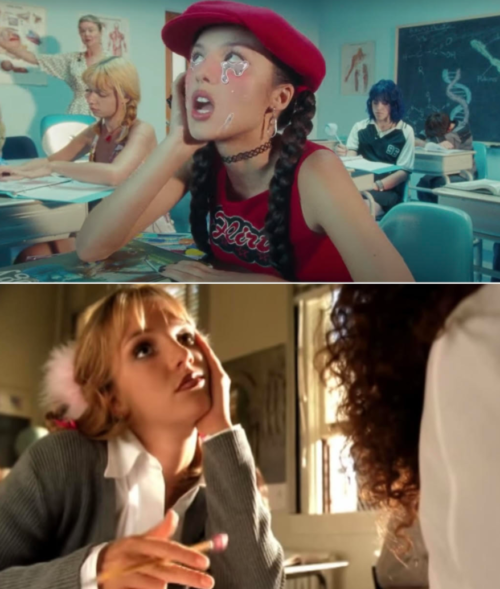Early on in her still germinal career, Olivia Rodrigo was accused of copying, well, quite a few people. The pastiche overload this “Gen Z representative” offers has drawn vocal and aesthetic comparisons ranging from Courtney Love to Paramore’s Hayley Williams to Britney Spears circa “…Baby One More Time” to Megan Fox in Jennifer’s Body to Avril Lavigne. All of these parallels hold water, and there’s a reason why Rodrigo seems to be the most over-the-top example yet of “borrowing” from the past. Yet “the past” has less and less bearing on determining what will prevent a musician or other artist from “repurposing” “elements” as capitalism detaches increasingly from the once more conventional experience of temporality.
Because all that capitalism—the system every industry bows to—can do is create a need to feed an insatiable beast, the endless churn-out of “content” as a means to service the “pleasure principle” of people getting more, more, more (even of things they don’t necessarily want), it leaves little room for artistic innovation. For taking the time to come up with something at least vaguely “different” instead of adhering to marketing “trends” (read: repackagings) that have already been “successful” (read: moneymaking) in previous decades would require too much stalling. Too much loss of potential profit in that gap spent innovating. While Rodrigo can swear up and down that all the ideas are her brainchild, there’s no denying that the record label and every other merchandising company with its tentacles on her is lapping up how “easily consumed” she is thanks to all of her familiar aesthetics.
Rodrigo, after all, exists in a time in which, despite claims of “dismantling” the system, society is at its most enmeshed in capitalism. In Fredric Jameson’s The Antinomies of Realism, it is argued that we live “between an unparalleled rate of change on all the levels of social life and an unparalleled standardization of everything—feelings along with consumer goods, language along with built space—that would seem incompatible with such mutability… What then dawns is the realization that no society has ever been as standardized as this one, and the stream of human, social and historical temporality has never flowed quite so homogenously.” As a result, Jameson posits that because “everything now submits to the perpetual change of fashion and media image…nothing can change any longer.” And Olivia Rodrigo being an amalgam of pretty much every major pop culture moment of the past twenty years is just such an example of that.
At the start of the Petra Collins-directed (she also helmed Rodrigo’s uber-familiar “good 4 u”) video for “brutal,” Olivia presents us with the style of the “kawaii” world, providing a series of her hyper-stylized “selves” as video game characters to be selected before appearing in a blue wig and ballerina ensemble as gentle string arrangements commence the track before the Paramore-meets-Avril Lavigne guitar notes begin. A “brutal” break of her ankle in half punctuates the shift in mood as she falls to the ground, now on the wooden floor of a dance studio as other ballerinas gleefully prance about her. She’s entered the “real” world, though that amounts to something more like the so-called “hyper-real,” complete with computer-animated facial flourishes that keep the wannabe Blackpink feeling going (here, too, it bears remarking that Rodrigo somehow appears inspired by Blackpink and Selena Gomez’s uninspired video for “Ice Cream”).
Things keep looking all too familiar as Rodrigo poses in a metallic silver crop top and too-tight pants that echo 00s-era Britney (think: her Pepsi phase—and yes, Rodrigo is even shilling a drink in the context of wearing this outfit). Ah, and speaking of often-imitated Britney, Rodrigo brings back the classroom backdrop to punctuate the lines, “I’m so sick of seventeen/Where’s my fuckin’ teenage dream?/If someone tells me one more time, ‘Enjoy your youth’/I’m gonna cry.” It’s all very “…Baby One More Time”—a clear favorite inspiration of Rodrigo’s, who was Britney’s same age of seventeen when her music career took off (or drove off, if you prefer). And it’s not just the classroom ennui, but also the continued use of schoolgirl outfits that pay homage to Spears as much as they do to Cher Horowitz. And being that Rodrigo is a loud and proud California girl, it should come as no surprise that this nod to Clueless is present, along with use of a traffic-laden parking lot that Rodrigo then wields to rip off the opening scene in La La Land where everyone ends up standing on top of their cars.
Rodrigo even finds a way to copy a contemporary—her only real contemporary, in fact—Billie Eilish (a fellow Californian, to boot). By wandering through a dead mall, Rodrigo not only eerily reminds us that gone are the days of when Spears could build a following with mall tours, but also of Eilish’s “Therefore I Am” video, shot in the Glendale Galleria. This nostalgia for the mall, despite being an apex representation of everything that’s wrong with capitalism, appeals to those of Rodrigo’s generation, who perhaps have never even dealt in that setting, precisely because it is not new. And because nostalgia is as much Capital as anything else: something to be sold.
Mark Fisher noted that “content” (since it can’t really be called art) produced under capitalism fortifies a lack of anything truly new being “produced” because that notion “looms up as hostile, fleeting, un-navigable; and the sufferer is drawn back to the security of the old. The inability to make new memories: a succinct formulation of the postmodern impasse.” Rodrigo is that succinct formulation of the moment. And there is no better evidence than her latest unoriginal video, which appeals entirely to 00s nostalgia (again, Lorde was wrong in saying, “Don’t you think the early 2000s seem so far away?”). From her Elle Woods flat cap to her Mean Girls-esque word tees, there is nothing in here that isn’t completely familiar, therefore utterly marketable.






















